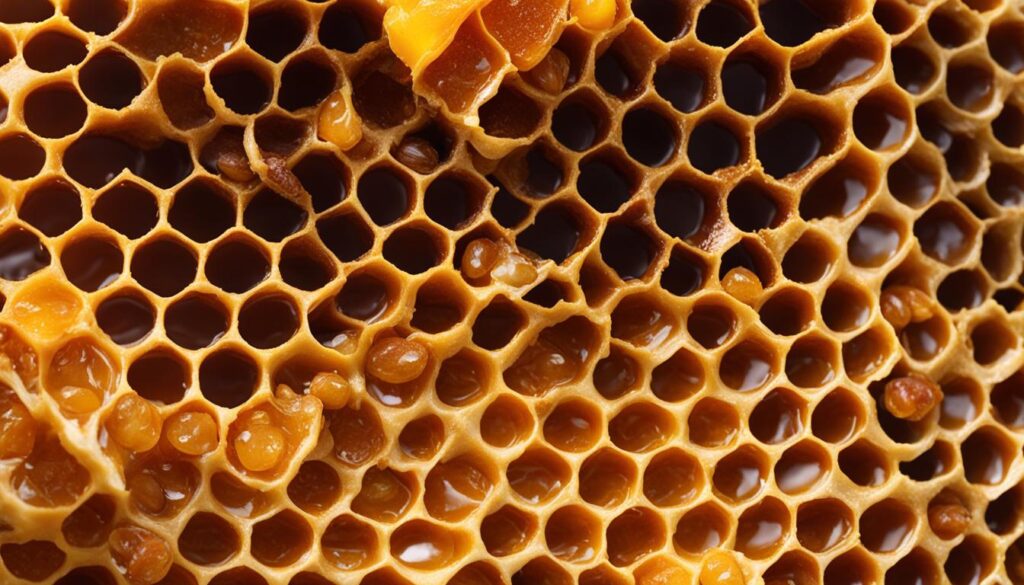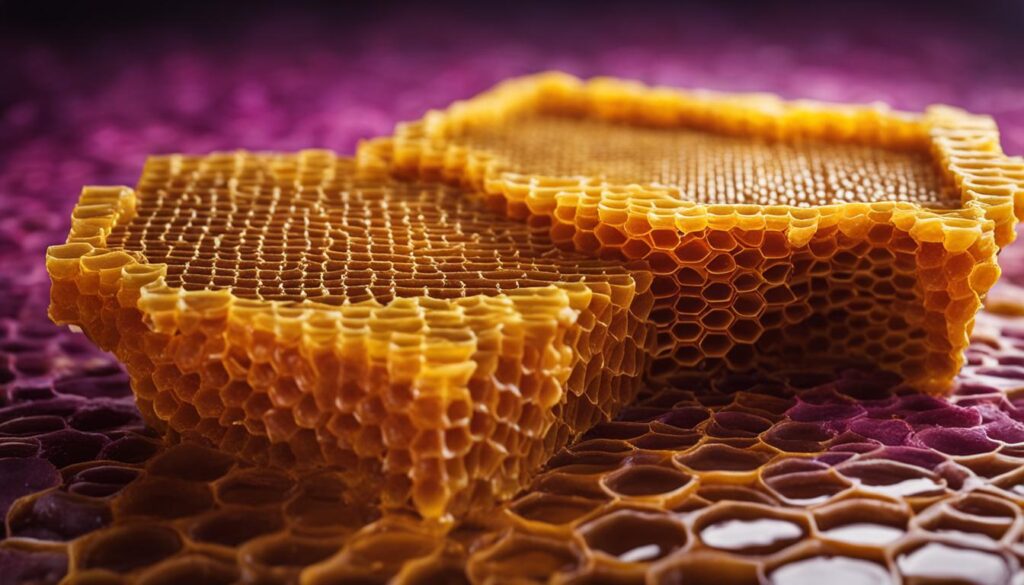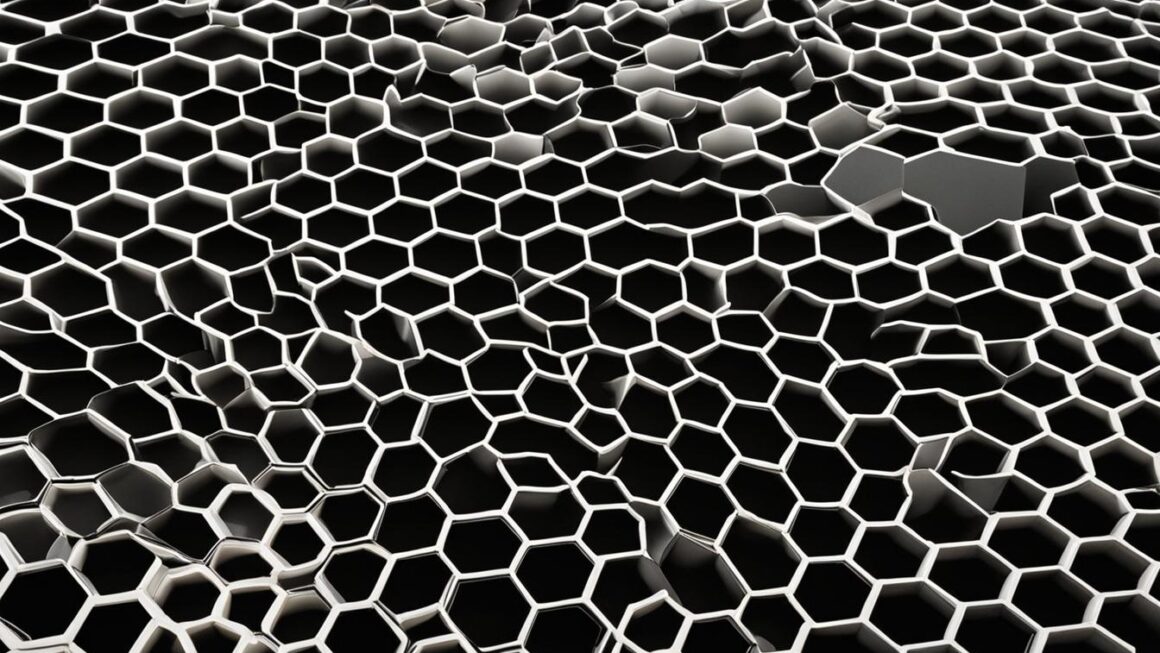Beeswax, a natural product made by honey bees, has long been used for various purposes. But can you eat beeswax? Is it safe? And are there any potential health benefits? Let’s explore the topic and find out.
Beeswax is primarily used by bees to store honey and pollen or house their larvae. It is composed of hexagonal cells constructed from beeswax, which contain raw honey. Raw honey itself is known for its potential health benefits, as it is rich in carbohydrates, antioxidants, enzymes, and polyphenols. Additionally, beeswax contains heart-healthy long-chain fatty acids and alcohols that may help lower cholesterol levels.
However, it’s important to note that consuming large amounts of beeswax may be harmful, so moderation is key. Let’s delve deeper into the intricacies of beeswax consumption.
Key Takeaways:
- Eating beeswax in moderation may offer potential health benefits due to the nutrients it contains.
- Raw honey, an integral part of beeswax, is rich in carbohydrates, antioxidants, enzymes, and polyphenols.
- Beeswax also contains heart-healthy long-chain fatty acids and alcohols that may help lower cholesterol levels.
- Consuming large amounts of beeswax can be harmful, so moderation is advised.
- Always consult your doctor if you have specific allergies or concerns related to beeswax consumption.
What is Honeycomb and How is it Made?
Honeycomb is a fascinating natural creation made by the diligent honey bees. It serves multiple purposes in their hive, including storing their larvae, honey, and pollen. But have you ever wondered how honeycomb is made? Let’s delve into the intriguing process.
To create honeycomb, worker bees produce wax scales from special glands located on their abdomen. They then chew and manipulate the wax scales to make them pliable. The bees meticulously mold the wax into hexagonal cells, carefully constructing the structure of the honeycomb. This hexagonal pattern allows for maximum storage capacity while using minimal wax.
Once the honeycomb cells are formed, they serve as storage units for honey, larvae, and pollen. The bees fill these cells with raw honey, which is a nutritious substance rich in carbohydrates, enzymes, antioxidants, and polyphenols. When you consume honeycomb, you are not only enjoying the raw honey but also the waxy cells that encase it.
The Honeycomb Structure
| Hexagonal Cells | Storage and Protection |
|---|---|
| The hexagonal shape of honeycomb cells allows for efficient use of space. | Honeycomb serves as a secure and protected environment for honey, larvae, and pollen. |
| Beeswax Walls | Strength and Durability |
| The walls of the honeycomb cells are made of beeswax, which provides strength and durability. | This structure can support the weight of honey, larvae, and pollen without collapsing. |
| Uniformity | Consistency and Balance |
| Honeycomb cells are uniform in size and shape, creating a harmonious and balanced structure. | This consistency allows for efficient organization and usage of resources within the hive. |
Nutritional Benefits of Honeycomb
Honeycomb is not only a delicious treat, but it also offers several nutritional benefits. This natural product is primarily made up of raw honey, which is rich in carbohydrates, antioxidants, enzymes, and polyphenols. These components provide a variety of potential health benefits for those who consume honeycomb.
Raw honey, the main component of honeycomb, contains small amounts of protein, vitamins, and minerals. It is a natural source of sugar and water, but it also retains enzymes like glucose oxidase, which give it antimicrobial and antibacterial properties. Raw honey is less likely to be contaminated with sweeteners like high-fructose corn syrup and contains more antioxidants than processed honey.
Additionally, honeycomb contains beeswax, which not only gives it its unique structure but also provides heart-healthy long-chain fatty acids and alcohols. These fatty acids have been shown to help lower cholesterol levels, promoting better heart health. The polyphenols present in honeycomb may also help reduce the risk of diabetes, dementia, heart disease, and certain types of cancer.
The Nutritional Composition of Honeycomb
| Nutrient | Amount per 100g |
|---|---|
| Carbohydrates | 82g |
| Protein | 0.3g |
| Fat | 0.1g |
| Vitamin C | 0.5mg |
| Calcium | 6mg |
| Potassium | 52mg |
| Iron | 0.42mg |
It’s important to note that while honeycomb does offer nutritional benefits, it should be consumed in moderation. Like any food, excessive consumption can lead to negative effects on health. If you have specific dietary concerns or allergies, it’s always recommended to consult with a healthcare professional before incorporating honeycomb into your diet.

Honeycomb and Potential Health Benefits
Honeycomb, with its natural components of raw honey and beeswax, offers a range of potential health benefits when consumed in moderation. Let’s explore some of these benefits:
Promotes Heart Health
Honeycomb has been found to have positive effects on heart health. Studies suggest that consuming honeycomb may help lower high blood cholesterol levels and increase levels of “good” HDL cholesterol. It may also help reduce blood pressure and decrease the risk of blood clots, heart attacks, and strokes.
Protects against Infections
Honeycomb possesses antimicrobial properties that can help strengthen the body’s defenses against bacterial and fungal infections. The enzymes found in raw honey have been shown to inhibit the growth of various disease-causing bacteria. Additionally, honeycomb can provide protection against certain parasites in the gut, contributing to overall health and well-being.
Reduces Coughing
Honeycomb has been traditionally used as a natural remedy for coughs and throat irritation. It can help soothe the throat and reduce coughing, especially in children with upper respiratory tract infections. The viscous texture and antimicrobial properties of honeycomb may provide relief and help alleviate discomfort.
Incorporating honeycomb into your diet can offer these potential health benefits. However, it’s important to note that more research is needed to fully understand and confirm these effects. It’s always advisable to consult with a healthcare professional before incorporating honeycomb into your diet, especially if you have any specific health conditions or concerns.
Honeycomb as a Sugar Alternative
For individuals with diabetes or those looking for healthier sweetening options, honeycomb can serve as a viable alternative to refined sugar. Due to its natural sweetness and lower glycemic index, honeycomb may have a lesser impact on blood sugar levels compared to regular table sugar. The use of honeycomb as a sugar alternative is a topic of interest, as it contains beeswax, which may have potential benefits for insulin resistance.
Beeswax, found in honeycomb, has been studied for its potential to reduce insulin resistance, a condition where the body’s cells become less responsive to the hormone insulin. Insulin resistance is often associated with high blood sugar levels and can be a precursor to type 2 diabetes. While more research is needed to fully understand the effects of beeswax on insulin resistance, studies have shown promising results.
Individuals with diabetes should still consume honeycomb in moderation, as it does contain carbohydrates and will affect blood sugar levels to some extent. It is always important to monitor blood sugar levels and consult with a healthcare professional before making any significant changes to your diet.
Table:
| Comparison | Honeycomb | Refined Sugar |
|---|---|---|
| Taste | Sweet, with distinct floral notes | Generic sweet taste |
| Glycemic Index | Lower | Higher |
| Nutritional Content | Contains small amounts of protein, vitamins, minerals, and beeswax with potential health benefits | No significant nutritional value |
It is worth noting that while honeycomb provides a more natural and potentially healthier alternative to refined sugar, it should still be consumed in moderation. Like any sweetener, excessive intake can contribute to weight gain and other adverse health effects. It is always recommended to consult with a healthcare professional or registered dietitian for personalized dietary advice.
Honeycomb and Liver Function
Honeycomb, specifically the beeswax alcohols it contains, may improve liver function and reduce symptoms in people with liver disease. In a study, individuals with liver disease who consumed beeswax alcohols reported a decrease in symptoms such as abdominal pain, bloating, and nausea, and some experienced a return to normal liver function. However, more research is needed to determine the optimal amount of honeycomb consumption for these benefits.
One study conducted on individuals with liver disease found that consuming beeswax alcohols found in honeycomb resulted in a significant improvement in liver function and a reduction in symptoms. The participants reported a decrease in abdominal pain, bloating, and nausea, and some even experienced a return to normal liver function. These findings suggest that honeycomb, with its beeswax alcohols, may have potential benefits for liver health.
While these preliminary findings are promising, further research is needed to fully understand the effects of honeycomb on liver function. It is also important to note that the optimal amount of honeycomb consumption for liver health has not been established. Therefore, it is recommended to consume honeycomb in moderation and consult with a healthcare professional for personalized advice.
| Benefits of Honeycomb on Liver Function | Recommendations |
|---|---|
| Improves liver function | Consume honeycomb in moderation |
| Reduces symptoms like abdominal pain, bloating, and nausea | Consult with a healthcare professional for personalized advice |
| May help restore normal liver function |
Overall, honeycomb, with its beeswax alcohols, shows potential in improving liver function and reducing symptoms, but more research is needed to fully understand its benefits and determine the optimal consumption amount. As with any dietary change, it is important to approach honeycomb consumption in moderation and seek advice from healthcare professionals for personalized recommendations.

How to Use Honeycomb
Honeycomb is a versatile ingredient that can be enjoyed in many different ways. Whether you prefer to eat it as-is or incorporate it into your favorite recipes, there are endless possibilities to explore. Here are some ideas on how to use honeycomb:
Straight from the Comb
One of the simplest and most delicious ways to enjoy honeycomb is to eat it straight from the comb. Simply break off a piece of the comb, and savor the sweet, sticky honey as it melts in your mouth. The comb itself adds a unique texture and depth of flavor, making this a truly indulgent treat.
Spread it on Toast
Honeycomb makes a delightful spread on toast or English muffins. Just take a piece of honeycomb and spread it on warm, freshly toasted bread. The heat from the toast will help soften the comb, making it easier to spread. Enjoy the combination of the crunchy comb and the creamy honey, creating a delectable contrast of textures.
Incorporate into Recipes
Get creative in the kitchen and incorporate honeycomb into your favorite recipes. Add chunks of honeycomb to homemade desserts like ice cream, cookies, or cakes for a burst of sweetness and a delightful chewy texture. You can also crumble honeycomb over pancakes, oatmeal, or yogurt for a natural and nutritious sweetener.
| Recipe | Description |
|---|---|
| Honeycomb Pancakes | Add crumbled honeycomb to your pancake batter for a delicious twist on a classic breakfast favorite. |
| Honeycomb Yogurt Parfait | Layer Greek yogurt, fresh fruits, and chunks of honeycomb for a healthy and indulgent dessert or snack. |
| Honeycomb Salad | Combine mixed greens with sliced fruit, nuts, and crumbled honeycomb for a unique and flavorful salad. |
Remember, honeycomb pairs well with a variety of ingredients, such as salad, fruit, charcuterie, and aged cheeses. Let your taste buds guide you and experiment with different flavor combinations to create your own culinary masterpieces.
Potential Dangers of Eating Honeycomb
While honeycomb is generally considered safe to eat, it’s important to be aware of potential risks that may arise. One concern is the possible contamination of honeycomb with C. botulinum spores. These spores can be harmful, especially to pregnant women and children under 12 months of age. It’s crucial to exercise caution and avoid feeding honeycomb to infants to prevent any potential health complications.
Another risk to consider is the potential for allergies. People with allergies to bee venom or pollen should be cautious when consuming honeycomb, as it may trigger an allergic reaction. It’s recommended to consult with a healthcare professional if you have specific allergies or concerns before incorporating honeycomb into your diet.
Lastly, consuming large amounts of honeycomb can lead to stomach obstructions. While honeycomb is safe when consumed in moderation, excessive consumption can cause digestive issues and discomfort. It’s important to practice moderation and enjoy honeycomb as part of a balanced diet.
| Risks of Eating Honeycomb | Precautions |
|---|---|
| Potential contamination with C. botulinum spores | Avoid feeding honeycomb to infants; exercise caution during pregnancy |
| Possible allergic reactions | Consult a healthcare professional if you have allergies to bee venom or pollen |
| Stomach obstructions | Consume honeycomb in moderation to avoid digestive issues |
Conclusion
In conclusion, honeycomb, including the beeswax it contains, is a natural and generally safe product with potential health benefits. It is rich in carbohydrates, antioxidants, enzymes, and polyphenols, making it a nutritious addition to your diet. However, moderation is key when consuming honeycomb, as excessive intake can be harmful.
Honeycomb has shown promising effects on heart health, including the potential to lower cholesterol levels and reduce the risk of blood clots and heart-related conditions. It also exhibits antimicrobial and antibacterial properties, which may help protect against infections and support a healthy gut. Additionally, honeycomb shows potential in reducing coughing in children with upper respiratory tract infections.
For individuals with diabetes, honeycomb can be a sweeter alternative to refined sugar and may have a lower impact on blood sugar levels. The beeswax found in honeycomb has been linked to improved liver function and reduced symptoms in people with liver disease. However, further research is needed to determine the optimal amount of honeycomb consumption for these specific benefits.
Overall, honeycomb can be enjoyed in various ways and adds both flavor and nutritional value to your meals. However, it’s important to be aware of potential risks, such as the presence of C. botulinum spores and the possibility of allergic reactions in individuals with bee venom or pollen allergies. If you have any concerns or specific allergies, it’s always best to consult a healthcare professional before incorporating honeycomb into your diet.
FAQ
Is it safe to eat beeswax?
Consuming beeswax in moderation is generally safe. However, eating large amounts of beeswax can be harmful and may cause stomach obstructions. It’s important to exercise moderation.
Can you eat beeswax?
Beeswax can be consumed, but it is primarily used to make honeycomb. Honeycomb, which contains beeswax, can be eaten in its entirety, including the waxy cells and raw honey they contain.
What is honeycomb and how is it made?
Honeycomb is a natural product made by honey bees to store their larvae, honey, and pollen. It is made by worker bees who produce wax scales from special glands. These scales are molded into hexagonal cells, creating the structure of honeycomb.
What are the nutritional benefits of honeycomb?
Honeycomb is rich in carbohydrates and antioxidants. Raw honey, the main component of honeycomb, contains small amounts of protein, vitamins, and minerals. Beeswax, which is found in honeycomb, provides heart-healthy long-chain fatty acids and alcohols.
What are the potential health benefits of honeycomb?
Honeycomb may promote heart health, reduce the risk of infections, and potentially benefit individuals with diabetes and liver disease. It may also help reduce coughing in children with upper respiratory tract infections. However, more research is needed to fully understand and confirm these potential health benefits.
Can honeycomb be used as a sugar alternative?
Honeycomb can serve as a natural sweetener and may be a good alternative to refined sugar for people with diabetes. It is sweeter than sugar and may have less impact on blood sugar levels. However, individuals with diabetes should still consume honeycomb in moderation.
How does honeycomb affect liver function?
Honeycomb, specifically the beeswax alcohols it contains, may improve liver function and reduce symptoms in people with liver disease. Studies have shown a decrease in symptoms and some individuals experiencing a return to normal liver function. More research is needed in this area.
How can honeycomb be used?
Honeycomb can be eaten as-is or used as a spread for bread or English muffins. It can also be used as a sweetener in homemade desserts or added to dishes like pancakes, oatmeal, or yogurt. Honeycomb pairs well with salad, fruit, charcuterie, and aged cheeses.
Are there any potential dangers of eating honeycomb?
Honeycomb may contain C. botulinum spores, which can be harmful to pregnant women and children under 12 months of age. Eating large amounts of honeycomb can also cause stomach obstructions. People with allergies to bee venom or pollen should exercise caution when consuming honeycomb, as it may trigger an allergic reaction.
What is the conclusion about eating honeycomb?
When consumed in moderation, honeycomb, including the beeswax it contains, is generally safe and can offer potential health benefits. However, it’s important to be aware of potential risks and consult a healthcare professional if you have specific allergies or concerns.




